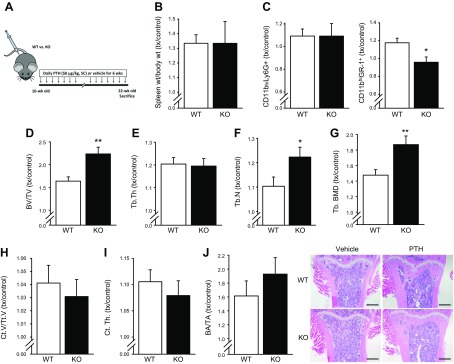Figure 5.
Anabolic response to PTH is greater in adult KO mice than WT. A) Experimental design. Daily injections of PTH (treatment, 50 μg/kg, s.c) were administered to female KO and WT mice (16 wk) or vehicle (control, 0.9% saline) for 6 wk and euthanized at 22 wk to assess spleen and marrow phenotypes. B) Spleens were harvested and weighed from vehicle and PTH-treated KO and WT mice. PTH treatment similarly increased spleen weight per body weight in both WT and KO mice (treatment:control >1.0). C) Marrow flow cytometric analysis for CD11bhiLy6G+ and CD11bhiGr-1+ populations showed that PTH treatment of WT mice resulted in increased CD11bhiGr-1+ populations (treatment:control >1.0) but no change was seen in PTH-treated compared to vehicle-treated KO mice (treatment:control ∼1.0). D–G) Trabecular analysis of proximal tibia via μCT. Both KO and WT displayed significantly increased BV/TV with PTH treatment. PTH treatment showed a greater anabolic effect in KO mice compared to WT. H, I) Cortical analysis of midshaft of tibia via μCT. WT and KO displayed increased cortical bone with PTH treatment. J) H&E-stained, paraffin-embedded sections of KO and WT tibiae treated with PTH or vehicle were quantified for bone area per total area. Both WT and KO mice had an anabolic response to PTH treatment (treatment:control >1.0). Scale bars, 500 µm. Data are means ± sem (n = 8–11/group). *P < 0.05, **P < 0.01.

